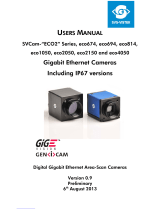
4
9.2 Color Processing ................................................................................................... 41
9.3 Color Adjustment – White Balance ....................................................................... 41
9.3.1 User-specic Color Adjustment ...................................................................... 41
9.3.2 One Push White Balance ............................................................................... 42
9.4 Analog Controls ..................................................................................................... 42
9.4.1 Offset / Black Level ......................................................................................... 42
9.4.2 Gain ................................................................................................................ 43
9.5 Pixel Correction ..................................................................................................... 44
9.5.1 General information ........................................................................................ 44
9.5.2 Correction Algorithm ....................................................................................... 45
9.5.3 Defectpixellist ................................................................................................. 45
9.6 Process Interface .................................................................................................. 46
9.6.1 Digital IOs ....................................................................................................... 46
9.6.2 IO Circuits ....................................................................................................... 47
9.6.3 Trigger ............................................................................................................ 48
9.6.4 Trigger Source ................................................................................................ 48
9.6.5 Debouncer ...................................................................................................... 49
9.6.6 Flash Signal .................................................................................................... 49
9.6.7 Timers ............................................................................................................. 50
9.6.8 Frame Counter ............................................................................................... 50
9.7 Sequencer ............................................................................................................. 51
9.7.1 General Information ........................................................................................ 51
9.7.2 Baumer Optronic Sequencer in Camera xml-le ............................................ 52
9.7.3 Examples ........................................................................................................ 53
9.7.4 Capability Characteristics of Baumer GAPI Sequencer Module .................... 53
9.7.5 Double Shutter ............................................................................................... 54
9.8 Device Reset ......................................................................................................... 54
9.9 User Sets .............................................................................................................. 55
9.10 Factory Settings .................................................................................................. 56
9.11 Timestamp ........................................................................................................... 56
10. Interface Functionalities ........................................................................................ 57
10.1 Device Information .............................................................................................. 57
10.2 Baumer Image Info Header ................................................................................. 57
10.3 Packet Size and Maximum Transmission Unit (MTU) ......................................... 58
10.4 Inter Packet Gap (IPG) ....................................................................................... 58
10.4.1 Example 1: Multi Camera Operation – Minimal IPG ..................................... 59
10.4.2 Example 2: Multi Camera Operation – Optimal IPG ..................................... 59
10.5 Transmission Delay ............................................................................................. 60
10.5.1 Time Saving in Multi-Camera Operation ...................................................... 60
10.5.2 Conguration Example ................................................................................. 61
10.6 Multicast .............................................................................................................. 63
10.7 IP Conguration .................................................................................................. 64
10.7.1 Persistent IP ................................................................................................. 64
10.7.2 DHCP (Dynamic Host Conguration Protocol) ............................................. 64
10.7.3 LLA ............................................................................................................... 65
10.7.4 Force IP ........................................................................................................ 65
10.8 Packet Resend .................................................................................................... 66
10.8.1 Normal Case................................................................................................. 66
10.8.2 Fault 1: Lost Packet within Data Stream ...................................................... 66
10.8.3 Fault 2: Lost Packet at the End of the Data Stream ..................................... 66
10.8.4 Termination Conditions ................................................................................. 67
10.9 Message Channel ............................................................................................... 68
10.9.1 Event Generation ......................................................................................... 68























